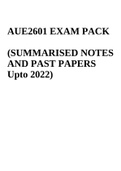Exam (elaborations)
AUE2601 EXAM PACK
- Institution
- University Of South Africa
AUE2601 EXAM PACK. This is a com0lete and an all-inclusive guide to AUE2601 - Auditing Theory And Practice The need for Auditing Services Jackson & Stent Chapter 1 ISA 200 – Objectives and general principles governing an audit ISA 610 International Framework for Assurance Engagements Extern...
[Show more]



